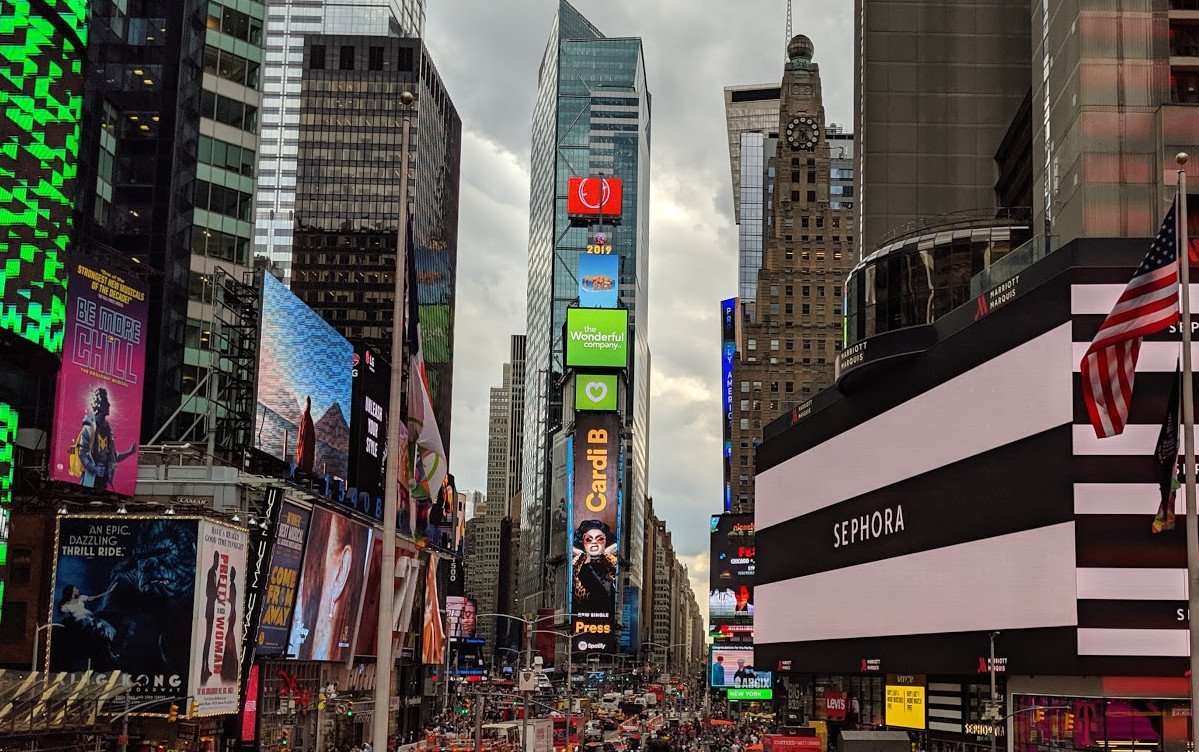Anyone who visits New York also goes to Times Square. You do not have to like the digital signage hotspot, but it makes everyone look up in awe – even invidis in early November 2019. An experience report by Florian Rotberg.
Some concepts are only possible in New York: Be it the world’s largest smart city project LinkNYC with a planned 10,000 outdoor totems or „of course“ the world’s largest robotic LED on the north side of Times Square. But even in New York, not everything goes as bold engineers and naive business partners imagine.
The best example is the Robotic LED wall. The installation was intended to be the highlight between the more than 50 LED walls around the famous intersection. Not only digitally dynamic, but also completely kinetic. With a format of 20.72 x 12.80 meters, the LED surface measures 265 square meters. It consists of 1,760 individually controllable and movable LED cubes.
But the Chinese concept does not really work. Already in the first winter after the installation the highly praised robotics stopped working. Coca-Cola could use the complex and certainly expensive installation merely as a simple LED wall. It seems, however, that they will give it another try: We discovered a whole team of technicians at and under the LED screen.
On the opposite side of Times Square, the latest Samsung LED wall from daughter company Prismview has been in place since summer, covering 1,100 square meters. Positioned prominently, the LED installation, which consists of several individual screens, stands out for two reasons: firstly because of its shape, and secondly because of the picture quality. By now, content can also run on entire area of the wall, which looks impressive. We experienced this with a T-Mobile campaign.
Roof installation dominates
Next to the former New York Times Building, which today only serves as the infrastructure for the Samsung Prismview and other LED installations, the new McDonalds flagship store on the east side of Times Square stands out. On the roof of the restaurant there is an installation that exceeds the height of the actual building many times. In the beginning, mainly McDonalds used the screen. In the meantime, companies such as Amazon and even some Chinese advertisers are booking the digital space and thus dominate the east side of the square. Not pretty – but that’s New York City.
Some digital signage installations are quite simple, but convincing just because they work – like the high-brightness screens of JC Decaux all over New York City. The large-format screens are integrated into newsstands; their content is easy to read even in direct sunlight.
SNA celebrated its Times Square video wall already long before the actual installation. It is by far not the biggest LED screen there, but according to the manufacturer the installation with the highest resolution. Probably just a temporary record – but the image quality is impressive.
Originally, the fully digital NFL Experience was supposed to move in at 20 Times Square. However, the venture between NFL and Cirque de Soleil was abandoned. From the outside it is not yet visible how the space will be used. In any case, the building is primarily used as advertising space – booked at times less and at other times more.
The largest LED wall at Times Square is still the Mitsubishi Wall on the Marriott Marquis. Unfortunately, the advertising content is usually split up among several customers at a time. As a result, a size-WoW effect is usually missing. T-Mobile has reserved a small corner for its flagship store below. In itself not spectacular. But the case shows how a comparably small store can attract a lot of attention with LEDs and the right content.
Get full access to all invidis yearbook articles – it’s free!
Download the industry bible for more analysis and market data. Secure your personal copy now – it’s free of charge.

